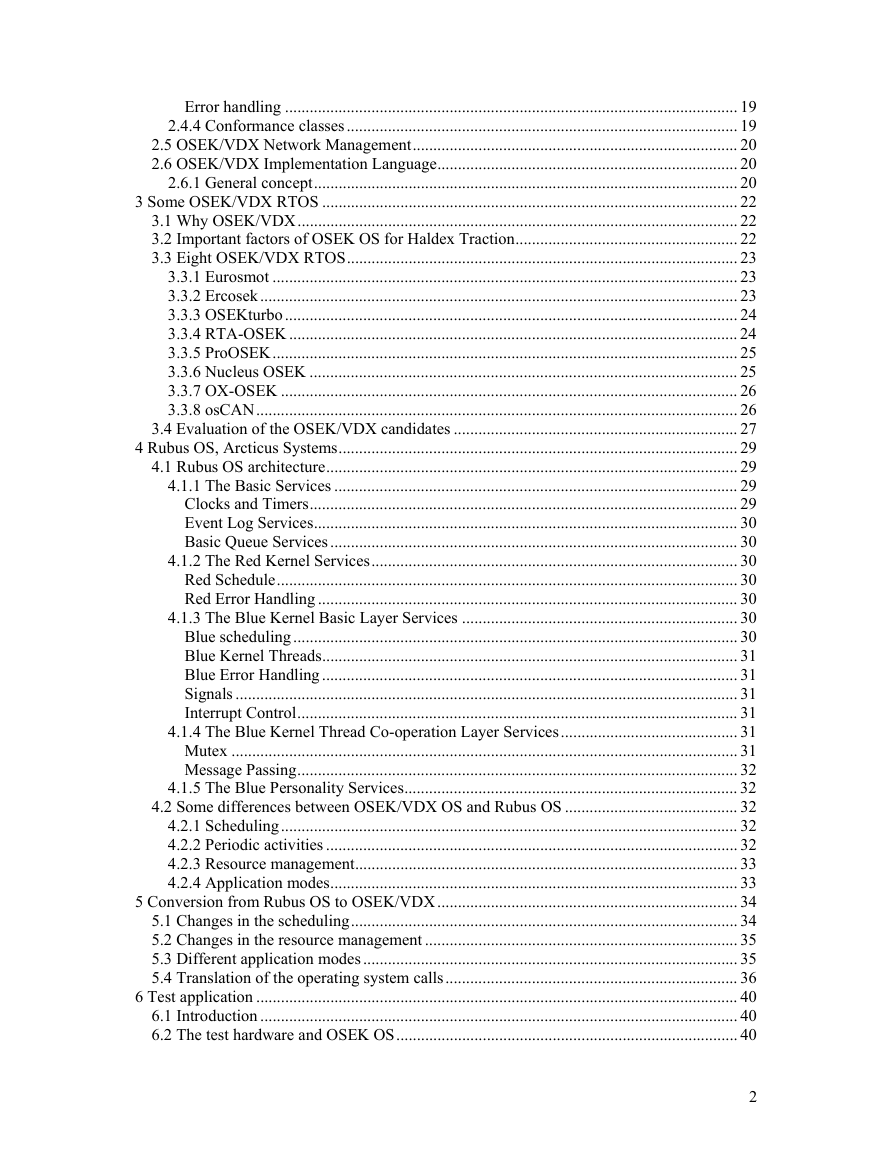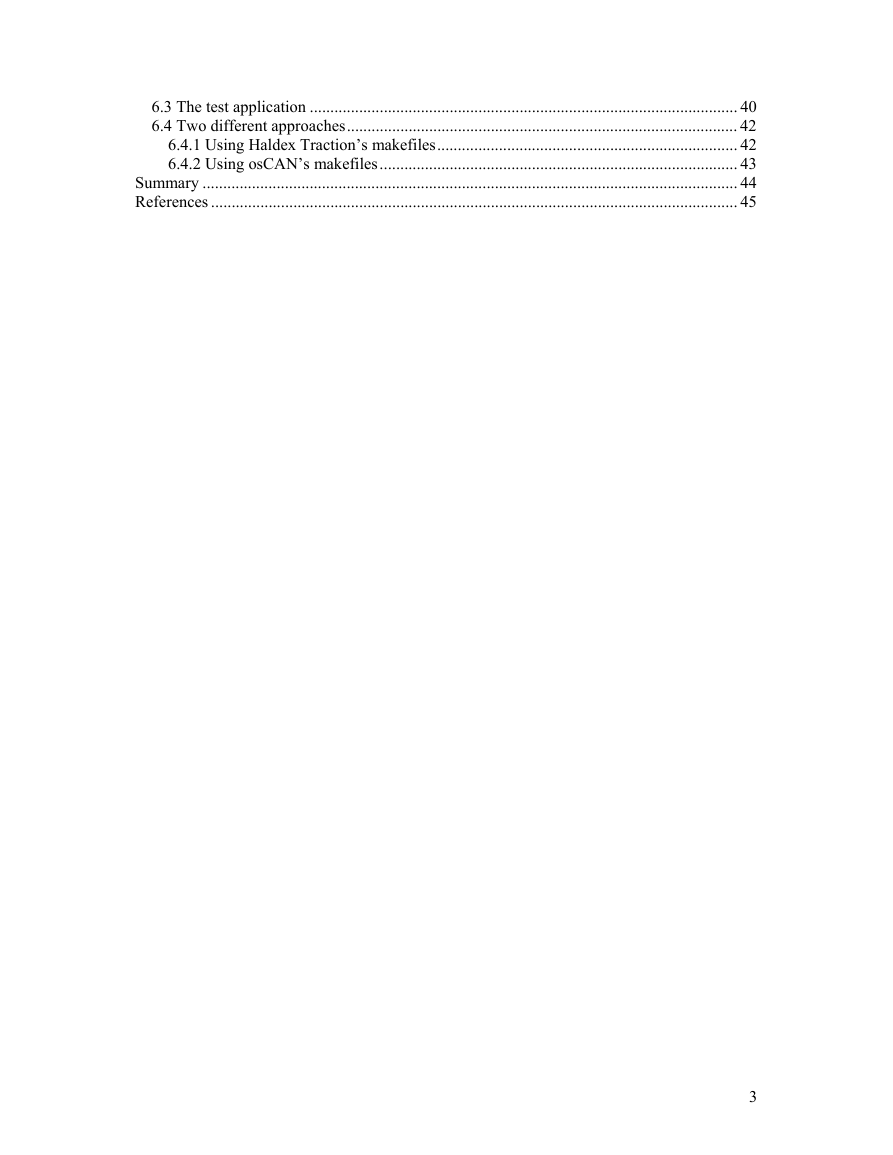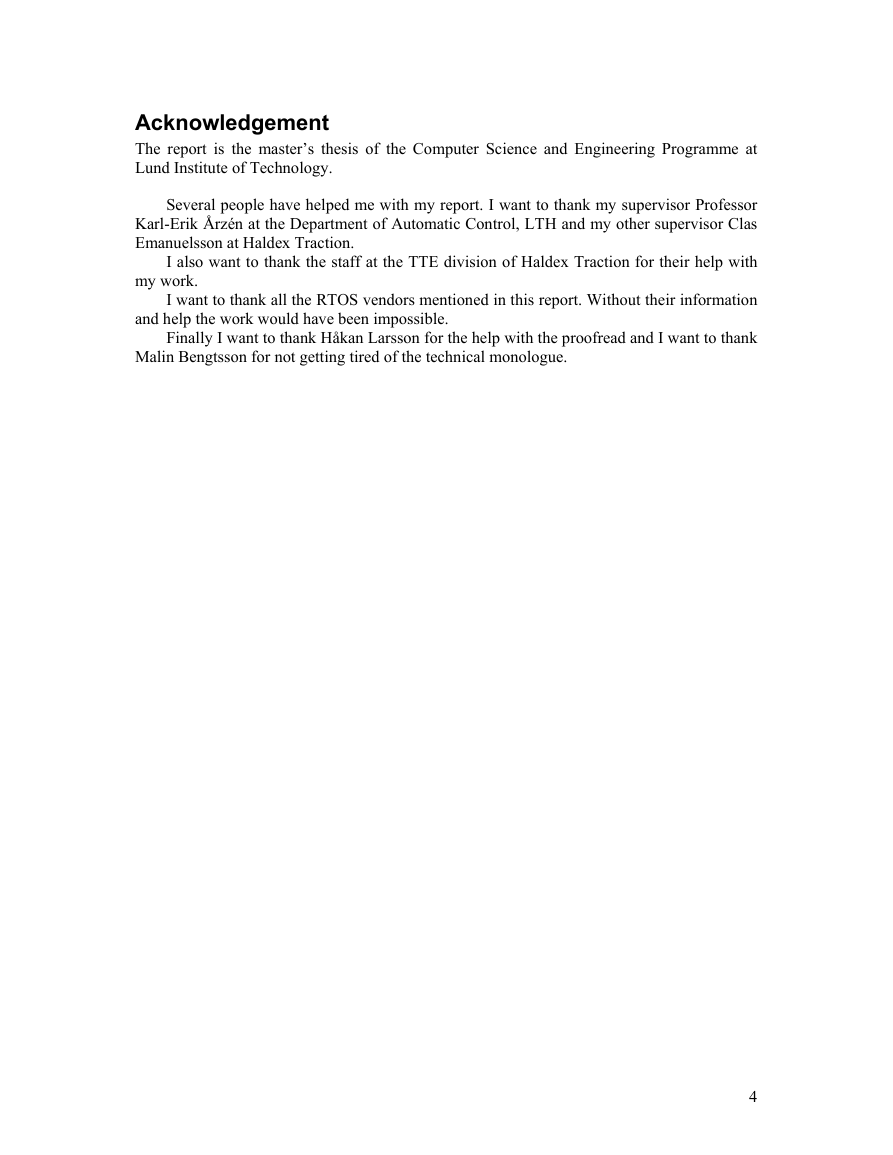ISSN 0280-5316
ISRN LUTFD2/TFRT--5731--SE
Investigation of Real-Time Operating
Systems : OSEK/VDX and Rubus
Pontus Evertsson
Department of Automatic Control
Lund Institute of Technology
December 2004
�
�
Department of Automatic Control
Lund Institute of Technology
Box 118
SE-221 00 Lund Sweden
Author(s)
Pontus Evertsson
Document name
MASTER THESIS
Date of issue
December 2004
Document Number
ISRNLUTFD2/TFRT--5731--SE
Supervisor
Karl-Erik Årzén at LTH in Lund
Clas Emanuelsson at Haldex Traction in Landskrona.
Sponsoring organization
Title and subtitle
Investigation of Real-Time Operating Systems: OSEK/VDX and Rubus (Analys av realtidsoperativsystem: OSEK/VDX
and Rubus)
Abstract
The aim of this work was to investigate the possibilities and consequences for Haldex Traction of starting to use the
OSEK/VDX standard for realtime operating systems. This report contains a summary of the realtime operating system
documents produced by OSEK/VDX. OSEK/VDX is a committee that produces standards for realtime operating systems
in the European vehicle industry. The report also contains a market evaluation of different OSEK/VDX realtime operating
systems. The main differences between OSEK/VDX OS and a realtime operating system named Rubus OS are also
discussed. There is a design suggestion of how to change an application that runs under Rubus OS to make it work with an
OSEK/VDX OS. Finally a test of changing a small test application’s realtime operating system from Rubus OS to the
OSEK OS osCAN is presented.
Keywords
Classification system and/or index terms (if any)
Supplementary bibliographical information
ISSN and key title
0280-5316
Language
English
Security classification
Number of pages
48
Recipient’s notes
ISBN
The report may be ordered from the Department of Automatic Control or borrowed through:University Library, Box 3, SE-221 00 Lund, Sweden Fax +46 46
222 42 43
�
�
Contents
Contents...................................................................................................................................... 1
Acknowledgement...................................................................................................................... 4
1 Introduction ............................................................................................................................. 5
1.1 Motivation for this work .................................................................................................. 5
1.2 Haldex AB........................................................................................................................ 5
1.2.1 Haldex Traction......................................................................................................... 5
The coupling................................................................................................................... 6
Basic function of the coupling ................................................................................... 6
Electronic control unit................................................................................................ 7
Software architectural design ..................................................................................... 7
1.3 Outline of the report ......................................................................................................... 8
2 OSEK/VDX............................................................................................................................. 9
2.1 Goal with OSEK/VDX..................................................................................................... 9
2.2 OSEK/VDX Operating System........................................................................................ 9
2.2.1 Architecture of the OSEK/VDX operating system ................................................... 9
Task management......................................................................................................... 10
Extended tasks.......................................................................................................... 10
Basic tasks................................................................................................................ 10
Conformance classes .................................................................................................... 10
2.2.2 Scheduling............................................................................................................... 11
Non preemptive scheduling.......................................................................................... 11
Full preemptive scheduling .......................................................................................... 11
Groups of tasks............................................................................................................. 11
Mixed preemptive scheduling ...................................................................................... 11
2.2.3 Application modes................................................................................................... 12
2.2.4 Interrupt processing................................................................................................. 12
2.2.5 Event mechanism .................................................................................................... 12
2.2.6 Resource management............................................................................................. 13
Problems with synchronisation mechanisms................................................................ 13
Priority inversion...................................................................................................... 13
Deadlocks................................................................................................................. 14
OSEK Priority Ceiling Protocol................................................................................... 14
2.2.7 Alarms ..................................................................................................................... 14
2.2.8 Error handling, tracing and debugging.................................................................... 15
2.3 OSEK/VDX Time-Triggered ......................................................................................... 16
2.3.1 Task management.................................................................................................... 16
2.3.2 Interrupt processing................................................................................................. 16
2.3.3 Synchronisation....................................................................................................... 17
2.3.4 Inter-Task Communication ..................................................................................... 17
2.3.5 Error handling ......................................................................................................... 17
2.4 OSEK/VDX Communication......................................................................................... 17
2.4.1 Requirements........................................................................................................... 17
2.4.2 Communication concept.......................................................................................... 17
2.4.3 Interaction Layer ..................................................................................................... 18
Overview ...................................................................................................................... 18
Message reception ........................................................................................................ 18
Message transmission................................................................................................... 18
Notification................................................................................................................... 19
1
�
Error handling .............................................................................................................. 19
2.4.4 Conformance classes............................................................................................... 19
2.5 OSEK/VDX Network Management............................................................................... 20
2.6 OSEK/VDX Implementation Language......................................................................... 20
2.6.1 General concept....................................................................................................... 20
3 Some OSEK/VDX RTOS ..................................................................................................... 22
3.1 Why OSEK/VDX........................................................................................................... 22
3.2 Important factors of OSEK OS for Haldex Traction...................................................... 22
3.3 Eight OSEK/VDX RTOS............................................................................................... 23
3.3.1 Eurosmot ................................................................................................................. 23
3.3.2 Ercosek.................................................................................................................... 23
3.3.3 OSEKturbo.............................................................................................................. 24
3.3.4 RTA-OSEK ............................................................................................................. 24
3.3.5 ProOSEK................................................................................................................. 25
3.3.6 Nucleus OSEK ........................................................................................................ 25
3.3.7 OX-OSEK ............................................................................................................... 26
3.3.8 osCAN..................................................................................................................... 26
3.4 Evaluation of the OSEK/VDX candidates ..................................................................... 27
4 Rubus OS, Arcticus Systems................................................................................................. 29
4.1 Rubus OS architecture.................................................................................................... 29
4.1.1 The Basic Services .................................................................................................. 29
Clocks and Timers........................................................................................................ 29
Event Log Services....................................................................................................... 30
Basic Queue Services ................................................................................................... 30
4.1.2 The Red Kernel Services......................................................................................... 30
Red Schedule................................................................................................................ 30
Red Error Handling ...................................................................................................... 30
4.1.3 The Blue Kernel Basic Layer Services ................................................................... 30
Blue scheduling ............................................................................................................ 30
Blue Kernel Threads..................................................................................................... 31
Blue Error Handling ..................................................................................................... 31
Signals .......................................................................................................................... 31
Interrupt Control........................................................................................................... 31
4.1.4 The Blue Kernel Thread Co-operation Layer Services........................................... 31
Mutex ........................................................................................................................... 31
Message Passing........................................................................................................... 32
4.1.5 The Blue Personality Services................................................................................. 32
4.2 Some differences between OSEK/VDX OS and Rubus OS .......................................... 32
4.2.1 Scheduling............................................................................................................... 32
4.2.2 Periodic activities .................................................................................................... 32
4.2.3 Resource management............................................................................................. 33
4.2.4 Application modes................................................................................................... 33
5 Conversion from Rubus OS to OSEK/VDX......................................................................... 34
5.1 Changes in the scheduling.............................................................................................. 34
5.2 Changes in the resource management ............................................................................ 35
5.3 Different application modes ........................................................................................... 35
5.4 Translation of the operating system calls....................................................................... 36
6 Test application ..................................................................................................................... 40
6.1 Introduction .................................................................................................................... 40
6.2 The test hardware and OSEK OS................................................................................... 40
2
�
6.3 The test application ........................................................................................................ 40
6.4 Two different approaches............................................................................................... 42
6.4.1 Using Haldex Traction’s makefiles......................................................................... 42
6.4.2 Using osCAN’s makefiles....................................................................................... 43
Summary .................................................................................................................................. 44
References ................................................................................................................................ 45
3
�
Acknowledgement
The report is the master’s thesis of the Computer Science and Engineering Programme at
Lund Institute of Technology.
Several people have helped me with my report. I want to thank my supervisor Professor
Karl-Erik Årzén at the Department of Automatic Control, LTH and my other supervisor Clas
Emanuelsson at Haldex Traction.
my work.
I also want to thank the staff at the TTE division of Haldex Traction for their help with
I want to thank all the RTOS vendors mentioned in this report. Without their information
and help the work would have been impossible.
Finally I want to thank Håkan Larsson for the help with the proofread and I want to thank
Malin Bengtsson for not getting tired of the technical monologue.
4
�
















 2023年江西萍乡中考道德与法治真题及答案.doc
2023年江西萍乡中考道德与法治真题及答案.doc 2012年重庆南川中考生物真题及答案.doc
2012年重庆南川中考生物真题及答案.doc 2013年江西师范大学地理学综合及文艺理论基础考研真题.doc
2013年江西师范大学地理学综合及文艺理论基础考研真题.doc 2020年四川甘孜小升初语文真题及答案I卷.doc
2020年四川甘孜小升初语文真题及答案I卷.doc 2020年注册岩土工程师专业基础考试真题及答案.doc
2020年注册岩土工程师专业基础考试真题及答案.doc 2023-2024学年福建省厦门市九年级上学期数学月考试题及答案.doc
2023-2024学年福建省厦门市九年级上学期数学月考试题及答案.doc 2021-2022学年辽宁省沈阳市大东区九年级上学期语文期末试题及答案.doc
2021-2022学年辽宁省沈阳市大东区九年级上学期语文期末试题及答案.doc 2022-2023学年北京东城区初三第一学期物理期末试卷及答案.doc
2022-2023学年北京东城区初三第一学期物理期末试卷及答案.doc 2018上半年江西教师资格初中地理学科知识与教学能力真题及答案.doc
2018上半年江西教师资格初中地理学科知识与教学能力真题及答案.doc 2012年河北国家公务员申论考试真题及答案-省级.doc
2012年河北国家公务员申论考试真题及答案-省级.doc 2020-2021学年江苏省扬州市江都区邵樊片九年级上学期数学第一次质量检测试题及答案.doc
2020-2021学年江苏省扬州市江都区邵樊片九年级上学期数学第一次质量检测试题及答案.doc 2022下半年黑龙江教师资格证中学综合素质真题及答案.doc
2022下半年黑龙江教师资格证中学综合素质真题及答案.doc